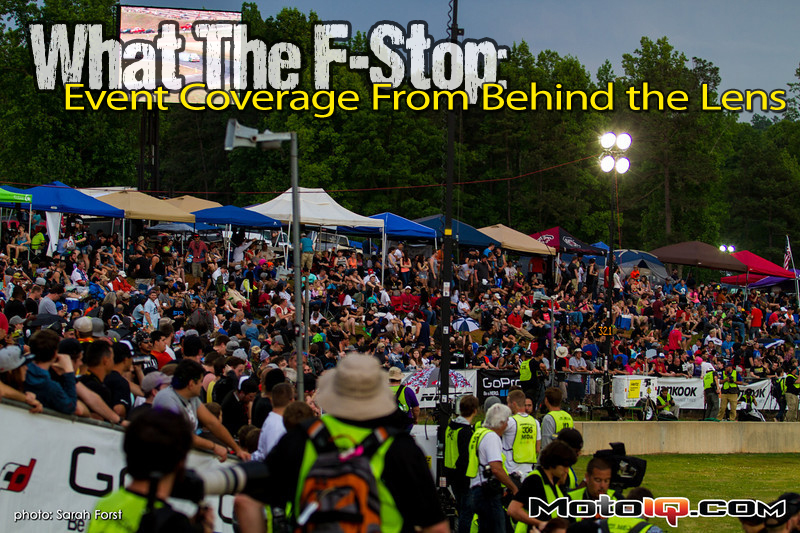
What the F-Stop: Event Coverage from Behind the Camera Lens
There's just something invigorating about the smell of race gas in the morning, the smoke produced by tires screeching, and the high pitched wail of a high horsepower engine going all out. And while I'd love to be on track owning that racket, I am just as excited to be covering it from behind a camera. From Formula Drift at Road Atlanta to 24 Hours of Nurburgring, my lame attempts at photography (“needs more blur”- thanks Jeff!) have taken me places I couldn't have dreamt about being so close to the action. And at the end of the day when I'm covered in rubber, drenched in either sweat or God's tears, and have claw hand from holding the camera grip for hours, I still have a smile on my sunburnt face. We're all familiar with swass- a condition that occurs when you're working arduously. Guy photogs complain about boxers turning into man thongs and something about oversalted nuts. It's just another hazard of covering a track day.
 The golf cart saves our lazy duffs from trekking between the pits and the track. We'll stuff 5 or 6 of us like a clown car- sometimes with Wes skating alongside and holding on for dear life- and flog it up the hills. It's also useful for ramming the porta-potty or holding the door shut when someone has an inopportune dump to take.
The golf cart saves our lazy duffs from trekking between the pits and the track. We'll stuff 5 or 6 of us like a clown car- sometimes with Wes skating alongside and holding on for dear life- and flog it up the hills. It's also useful for ramming the porta-potty or holding the door shut when someone has an inopportune dump to take.It's the stuff that wet dreams are made of- that privileged vest that affords me access to cars I would love to be behind the wheel of. Race coverage is a funny thing. You’re drunk on race gas, high on exhaust gas, and red like a lobster. You get an asphalt facial, burnt rubber shampoo, and rock bath. It’s almost as addicting being behind the camera and these events are like family reunions for us photogs who have forged amazing friendships over our passion for cars and love of photography.
 Into the smoke is not usually a good shot so once you nail a photo, you can put the camera down a little to watch the drama unfold.
Into the smoke is not usually a good shot so once you nail a photo, you can put the camera down a little to watch the drama unfold.  5 seconds of fame- the things fans will do in an effort to being photographed. Helmets should be left to the drivers.
5 seconds of fame- the things fans will do in an effort to being photographed. Helmets should be left to the drivers. Strangely enough, there was a supply of hoses just below the sign…
Strangely enough, there was a supply of hoses just below the sign…The Equipment
Most photogs are carrying a minimum of a car loan around their necks and in some cases it’s a cheap mortgage. First choice- Canon or Nikon? Both choices offer DLSR options for about $1k which include a starter 18-55m lens. Upgrading to a better camera body offer faster continuous shooting, better autofocus, and more functionality. Camera bodies are mostly disposable but lens are worth the investment.
Nikon camera bodies and lens are all pretty compatible since 1959. When Canon introduced the AF cameras and EOS lens in 1987, they pretty much started over in terms of compatibility. For most of us who had 110 camera at that time, no biggie since our camera investments took place the last decade or two. All bodies/lenses manufactured since 1987 are compatible and the Canon collection was so much better at focus speed around the turn of the millennium that most photographers who shot sports or auto racing became Canon aficionados. Nikon bodies and lenses are tantamount to those by Canon but if you started with Canon a decade ago, chances were you didn’t want to spend the thousands of dollars required to reconfigure all of your photography gear.
I can go through advantages of each but just like a car, if you’re going to invest in something that costs so much, take it for a test drive. See which one you prefer for the type of shooting you’ll do and which camera feels comfortable. My experience has been mostly with Canons and I'm happy with the product and outcome but practice makes perfect. Shoot (no pun intended), the photos I take now are significantly better than ones I took years ago and I'd like to think it’s not just equipment.



